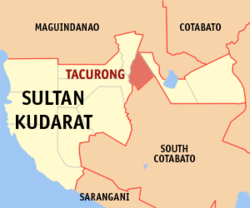Tacurong
| Tacurong | ||
| Location of Tacurong in the Sultan Kudarat Province (province) | ||
|---|---|---|

|
||
| Basic data | ||
| Region : | SOCKSARGEN | |
| Province : | Sultan Kudarat (Province) | |
| Barangays : | 20th | |
| District: | 1. District of Sultan Kudarat (Province) | |
| PSGC : | 126500000 | |
| Income class : | 5th income bracket | |
| Households : | 14,950 May 1, 2000 census
|
|
| Population : | 812.095 August 1, 2015 census
|
|
| Population density : | 5299 inhabitants per km² | |
| Area : | 153.26 km² | |
| Coordinates : | 6 ° 42 ′ N , 124 ° 41 ′ E | |
| Postal code : | 9800 | |
| Area code : | +63 64 | |
| Mayor : | Lino O. Montilla | |
| Geographical location in the Philippines | ||
|
|
||
Tacurong is one of the city in the Philippine province of Sultan Kudarat on the island of Mindanao .
The city was previously known as Pamansang .
Origin of name
The name of today's city is derived from the name Talakudong from the Maguindanao language. This is a term for a headdress worn by the early settlers and the people of the area.
Why the place was associated with a headgear can no longer be understood today. What is certain, however, is that the term Tacurong is a shortened and modified form of the term Talakudong .
Language and religion
Most of the city's residents are descendants of Iloilo immigrants . Accordingly, Ilonggo is the mother tongue of 53,780 people or 70.37% of the residents. 11,838 or 15.49% speak the dialect Ilocano, while the remaining 14.14% of the residents communicate in other languages, such as Cebuano (4.33%), Maguindanao (3.69%), Tagalog (3.61%) and other dialects (2.51%).
The dominant religion is Roman Catholic with 58,371 believers, which makes up 83.6% of the population. 5.18% or 3,616 are followers of Islam and 11.22% belong to other religious groups.
geography
Tacurong is located in the center of Mindanao Island . The city is 92 km from General Santos , 96 km from Cotabato City and 178 km from Davao City .
The urban area is surrounded by the community of Lambayong in the north, Isulan in the west, Pres. Quirino in the east and from Tantangan from the province of South Cotabato in the south.
The terrain of the urban area is mostly flat. About 84% is level and has a gradient of no more than 8%. The steeper areas can be found in the southeast of the city. The area is criss-crossed by numerous waterways and streams that flow through Tucarong from south to north.
Barangays
Tacurong is politically divided into 20 barangays .
|
|
history
The place, the later city of Tacurong, was once a Baranggay of the administrative municipality Buluan and belonged to the former large province of Cotabato. The place was then still called “Pamansang”, after a stream that flows through the area from north to south.
In 1940 the place became a transit station for travelers and Christian missionaries on their way to various stations in Cotabato.
By Executive Order No. 462, issued by the later President Elpidio Quirino , Tacurong was separated from Buluan on August 3, 1951 and appointed an independent administrative municipality. At that time Tacurong consisted of 14 barangays .
When the district of Tantangan was detached from the administrative municipality in 1961 and made its own municipality, Tacurong lost all of its southern areas. On November 22nd, by Presidential Decree No. 341, the new Sultan Kudarat Province was formed, to which a total of 12 parishes belonged. Although Isulan Municipality was awarded the seat of provincial government, Tacurong remained the leading municipality in the new province.
Through the efforts of Congressman Angelo O. Montilla, the entry into force of Republic Act No. 8805, signed by President Joseph Estrada , changed the status of the municipality after 49 years and made it a Component City on August 16, 2000 Sultan Kudarat Province . The appointment was confirmed by a referendum of the townspeople on September 18.
economy
A few years ago, the residents of Tacurong made their living mainly from agriculture, while only a small part of the local income was covered by commercial institutions.
Due to the influence of immigrants and the admission of refugees from neighboring places, the course of the city changed and led to an economic development away from agriculture to national economy and various industries.
The growth of small investors encouraged artisanal businesses such as furniture processing, confectionery factories and vinegar-producing businesses. The city is also home to metalworking plants, pottery, weaving and the food industry.
The main industries are rice and wheat mills and agricultural trade. The city is home to the country's largest grain processing complex.
The city also produces African palm oil , which is exported to Manila and used there for the manufacture of plastics and soaps.
climate
The city of Tacurong falls under the fourth type of climate category, characterized by year-round rainfall. The average rainfall is 127.64 mm.
The average temperatures vary between 27.36 and 27.56 ° C. The relative humidity is 80%.
